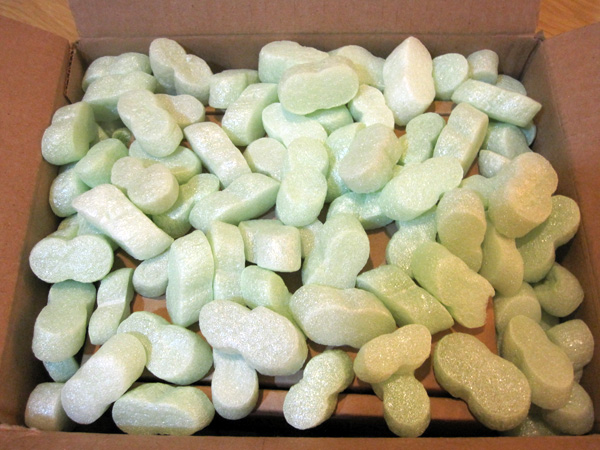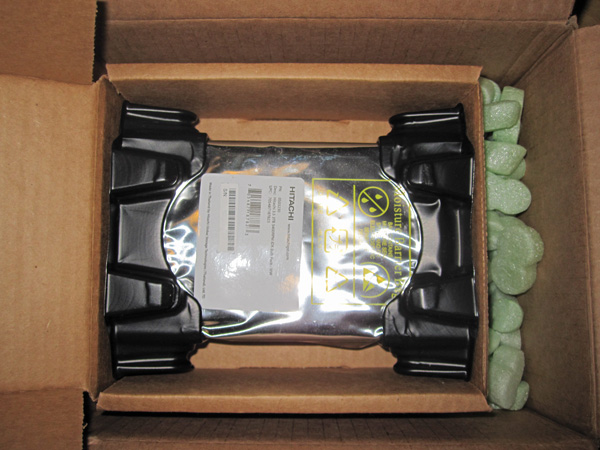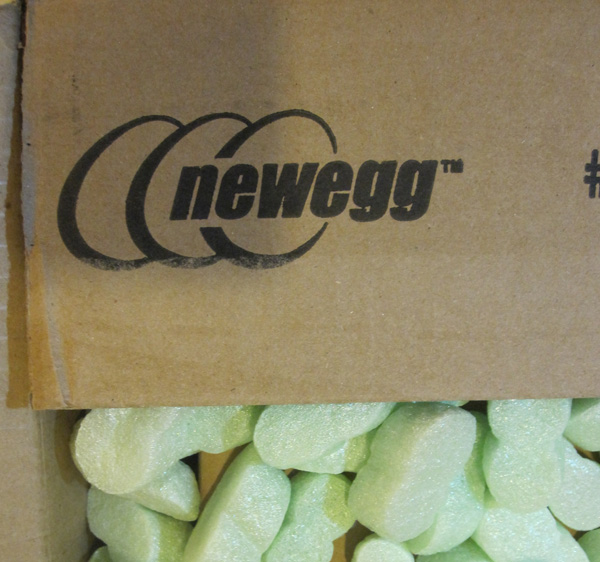One area where Newegg has had a poor reputation over the past few years has been hard drive packaging. Recently I have picked up a few OEM Hitachi (bulk) drives from NewEgg and have seen first-hand the new packaging. Since Internet reviews seemingly last a lifetime, I thought it was important to provide a point of view regarding Newegg packaging as of today. Note, this piece is not endorsed by Newegg so it is very possible that the company may change practices tomorrow.
The previous method of Newegg single-drive packaging (when purchasing a non-retail drive) involved placing a bare drive enclosed in a ESD bag into a shipping box with foam peanuts. This method, in my experience, oftentimes led to one finding a portion of the drive directly against the cardboard container. As someone that purchases a multitude of drives, this is not best practice. In fact, hard drive manufacturers prefer not to see this packing method when sending in a defective drive under an RMA to be replaced. This Newegg practice saw numerous complaints, and it appears as though Newegg is responding in a very positive manner. Here is a look at the new packaging.
The first thing one notices is that the packaging retains the outer, Newegg.com branded cardboard box. Inside the box one immediately sees familiar foam peanuts.

Moving beyond the outer box, foam peanuts become clearly visible and are found in sufficient quantity to provide a protective cushion between the outer box and an inner box. This inner box is probably the biggest improvement I have seen in Newegg packaging in a long time.

Inside this second inner box is what is considered the best practice packing method. The inner box not only provides another layer of protection, but also is properly sized to isolate the drive. The Hitachi 3TB drive in question, inside its ESD bag, is held suspended by two black end caps that isolate the drive from the inner box. This inner structure is similar to both the way hard drive OEMs package their retail products and also how drives are packaged when sent to customers as RMA replacement drives.
For those keeping track, that means there are two cardboard boxes providing protection alongside foam peanuts and the drive end caps providing cushioning inside each box, or more protection than a standard retail box. Comparing this packaging to OEM packaging, it is at least on par if not better.
Conclusion
Putting this all together, one can read Newegg reviews and see user perception that the previously used, less protective packaging was cited in many hard drive DOA 1 egg reviews. Indeed, there is a reason hard drive OEMs tend to package drives more conservatively than the former peanuts and lose drive in a cardboard box method employed by Newegg. With its new packaging, Newegg is shipping the newer Hitachi 5K3000 drives with probably more protection than is needed. This shows that the company is being responsive to feedback, and it is a change that ultimately benefits the consumer. Although DOA drives have multiple avenues to receive a new drive available, having a hard drive arrive in working condition saves a lot of hassle for the customer. There are several other companies that do not package drives this well, and as consumers we should hope that the other retailers follow suit with their single, bare drive shipments.
Experiences with vendor packaging? Feel free to discuss on the ServeTheHome.com Forums.





I’ve noticed the change in packaging as well and am pleased to see the change. In the past, I have had drives arrive packaged on the bottom of box with essentially no packing to protect from the impacts of setting the box down. It’s no fun to find a brand new WD Black drive DOA due to what was likely a bad packing job.
This is great to hear. I just ordered 5x 1.5TB Hitachi 7K3000 OEM’s and was worried.
Sometimes with more than single drives they use part of bigger packs that are broken down. Will be interested to see what you get.
They have not solved the problem yet.
I just received a few WD Enterprise-class SATA drives from Newegg and I’ve go to say their packaging was *horrible*.
They bundled up the drives together in a broken foam latttice
that left one side of the bundle exposed then wrapped the whole
mess in *one layer* of large-cell bubble wrap and set it in a
larger box with the unfoamed side down. Nothing but a single
layer of bubble wrap between two of the drives and the bottom
of the outer box.
All of the bubbles on that side were completely popped by the time
it reached its destination so the bottom drives were resting
directly on the bottom of the outer box.
This is insane.
Of course one of them was DOA.
Hey Steve. How many were in the box? Multi-drive shipments I have seen similar things happen.
Hey would you mind letting me know which hosting company you’re utilizing? I’ve loaded your blog in 3 different web browsers and I must say this blog loads a lot quicker then most. Can you recommend a good hosting provider at a honest price? Thank you, I appreciate it!|